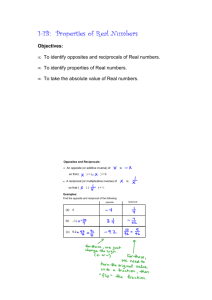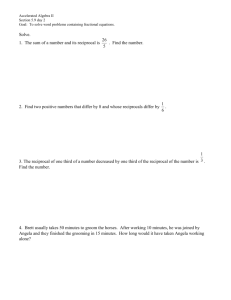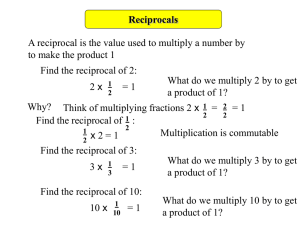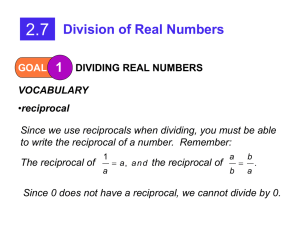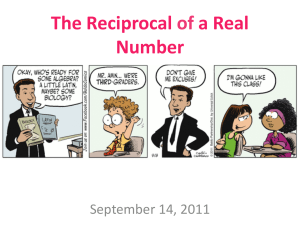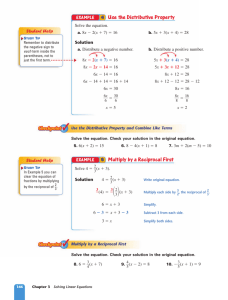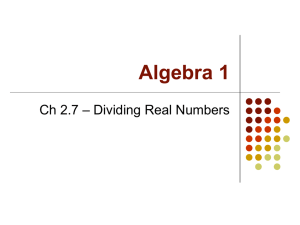paper
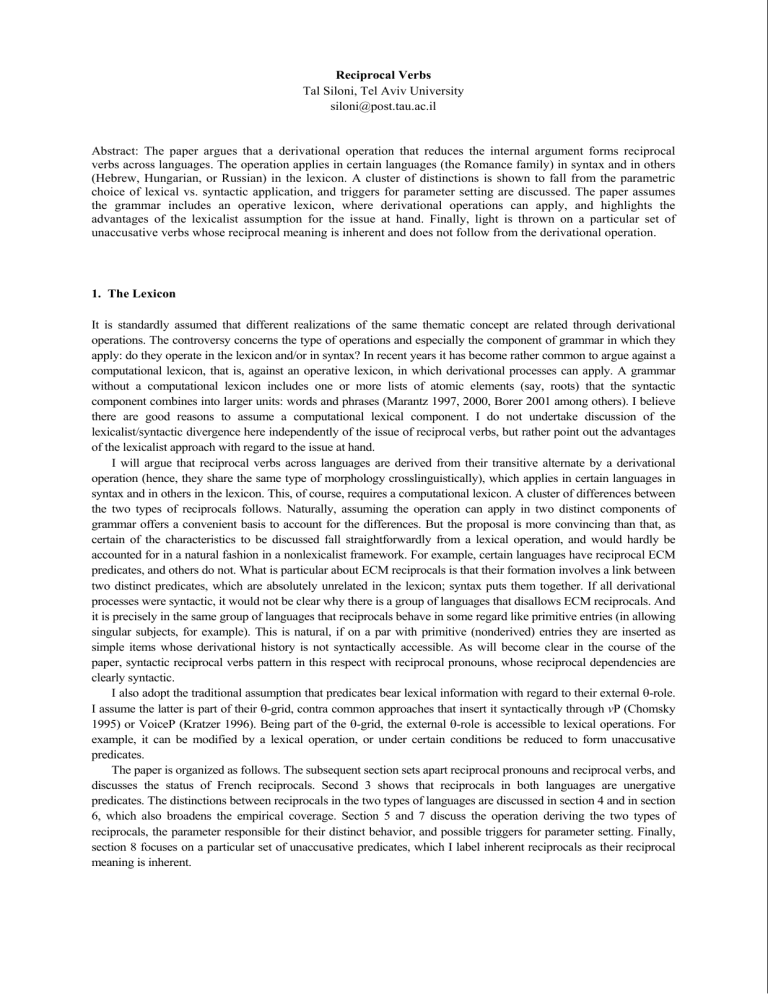
Reciprocal Verbs
Tal Siloni, Tel Aviv University siloni@post.tau.ac.il
Abstract: The paper argues that a derivational operation that reduces the internal argument forms reciprocal verbs across languages. The operation applies in certain languages (the Romance family) in syntax and in others
(Hebrew, Hungarian, or Russian) in the lexicon. A cluster of distinctions is shown to fall from the parametric choice of lexical vs. syntactic application, and triggers for parameter setting are discussed. The paper assumes the grammar includes an operative lexicon, where derivational operations can apply, and highlights the advantages of the lexicalist assumption for the issue at hand. Finally, light is thrown on a particular set of unaccusative verbs whose reciprocal meaning is inherent and does not follow from the derivational operation.
1. The Lexicon
It is standardly assumed that different realizations of the same thematic concept are related through derivational operations. The controversy concerns the type of operations and especially the component of grammar in which they apply: do they operate in the lexicon and/or in syntax? In recent years it has become rather common to argue against a computational lexicon, that is, against an operative lexicon, in which derivational processes can apply. A grammar without a computational lexicon includes one or more lists of atomic elements (say, roots) that the syntactic component combines into larger units: words and phrases (Marantz 1997, 2000, Borer 2001 among others). I believe there are good reasons to assume a computational lexical component. I do not undertake discussion of the lexicalist/syntactic divergence here independently of the issue of reciprocal verbs, but rather point out the advantages of the lexicalist approach with regard to the issue at hand.
I will argue that reciprocal verbs across languages are derived from their transitive alternate by a derivational operation (hence, they share the same type of morphology crosslinguistically), which applies in certain languages in syntax and in others in the lexicon. This, of course, requires a computational lexicon. A cluster of differences between the two types of reciprocals follows. Naturally, assuming the operation can apply in two distinct components of grammar offers a convenient basis to account for the differences. But the proposal is more convincing than that, as certain of the characteristics to be discussed fall straightforwardly from a lexical operation, and would hardly be accounted for in a natural fashion in a nonlexicalist framework. For example, certain languages have reciprocal ECM predicates, and others do not. What is particular about ECM reciprocals is that their formation involves a link between two distinct predicates, which are absolutely unrelated in the lexicon; syntax puts them together. If all derivational processes were syntactic, it would not be clear why there is a group of languages that disallows ECM reciprocals. And it is precisely in the same group of languages that reciprocals behave in some regard like primitive entries (in allowing singular subjects, for example). This is natural, if on a par with primitive (nonderived) entries they are inserted as simple items whose derivational history is not syntactically accessible. As will become clear in the course of the paper, syntactic reciprocal verbs pattern in this respect with reciprocal pronouns, whose reciprocal dependencies are clearly syntactic.
I also adopt the traditional assumption that predicates bear lexical information with regard to their external θ -role.
I assume the latter is part of their θ -grid, contra common approaches that insert it syntactically through v P (Chomsky
1995) or VoiceP (Kratzer 1996). Being part of the θ -grid, the external θ -role is accessible to lexical operations. For example, it can be modified by a lexical operation, or under certain conditions be reduced to form unaccusative predicates.
The paper is organized as follows. The subsequent section sets apart reciprocal pronouns and reciprocal verbs, and discusses the status of French reciprocals. Second 3 shows that reciprocals in both languages are unergative predicates. The distinctions between reciprocals in the two types of languages are discussed in section 4 and in section
6, which also broadens the empirical coverage. Section 5 and 7 discuss the operation deriving the two types of reciprocals, the parameter responsible for their distinct behavior, and possible triggers for parameter setting. Finally, section 8 focuses on a particular set of unaccusative predicates, which I label inherent reciprocals as their reciprocal meaning is inherent.
Reciprocal Verbs
2. Reciprocal verbs vs. reciprocal pronouns
Hebrew forms reciprocal sentences using one of its reciprocal pronouns (1a) or by way of a reciprocal verb (1b).
Many reciprocal verbs appear in the hitpa’el morphological template (1b), and some in nif’al (1d).
(1) a hem nišku ze et ze/ exad et ha-šeni.
they kissed this acc this/ one acc the-second
‘They kissed each other’
they rec ) c hem pagšu ze et ze/ exad et ha-šeni.
they met this acc this/ one acc the-second
‘They met each other’
they rec )
2.1 Interpretative differences
The two modes of expression of reciprocity in (1) seem equivalent, but in more articulated contexts interpretative differences are revealed between the two modes. Thus, both (2a) and (3a), which use a reciprocal pronoun, are ambiguous in a way their counterparts with a reciprocal verb are not.
(2) a dan ve-ron xibku ze et ze xameš pe’amim.
Dan and-Ron hugged each other five times i There were five mutual hugging events. ii There were ten hugging events: five by Dan and five by Ron. b dan ve-ron hitxabku xameš pe’amim.
Dan and-Ron hugged( rec ) five times i There were five mutual hugging events.
(3) a dan ve-ron amru še-hem katvu ze la-ze.
Dan and-Ron said that-they wrote one to the other i Dan and Ron said that they corresponded. ii Dan said that he wrote to Ron and Ron said that he wrote to Dan. b dan ve-ron amru še-hem hitkatvu.
Dan and-Ron said that they wrote( rec ) i Dan and Ron said that they corresponded.
Following Heim, Lasnik & May 1991, who discuss ambiguities of the type in (3a), I assume reciprocal pronouns are complex expressions composed of a distributor ( each ) and a reciprocator ( other ). The distributor, a marker of distribution, raises and adjoins its antecedent at LF for reasons of scope. In (2a) we get five hugging events in case the adverbial ‘five times’ takes scope over the distributor ( ze ) adjoined to the subject, and ten hugging events when the distributor has wide scope. In (3a) the ambiguity depends on whether the distributor covertly adjoins to the local or matrix subject. This is schematized in (4).
(4) Scope ambiguities: [five times] [ DP each]
[DP each] [five times]
[Dan and Ron] [they each]
(2ai)
(2aii)
(3ai)
(3aii) [Dan and Ron each] [they]
Likewise (5a) is contradictory because it can only mean that Dan and Ron defeated each other, but (5b) has also a noncontradictory interpretation that Dan said he defeated Ron and Ron said he defeated Dan, which is obtained by long raising of the distributor to take scope over the matrix subject.
2
Reciprocal Verbs
(5) a dan ve-ron nicxu exad et ha-šeni.
Dan and-Ron defeated each other b dan ve-ron amru še-hem nicxu exad et ha-šeni.
(contradictory)
Dan and Ron said that-they defeated each other
As noted by Heim, Lasnik & May 1991, if (covert) movement is involved in the interpretation of reciprocal pronouns, we expect it to be sensitive to restrictions on syntactic movement. This is indeed so. The sentences in (6) are contradictory as the distributor cannot take scope outside the island in which it is embedded: a complex NP in (6a) and a subject in (6b).
(6) a dan ve-ron te’aru et ha-krav še-bo hem nicxu exad et ha-šeni.
Dan and Ron described the-battle that-in+it they defeated each other b dan ve-ron amru še-ha-uvda še-hem nicxu exad et ha-šeni lo
(contradictory)
Dan and Ron said that-the-fact that-they defeated each other neg
damage( fut ) on relationship-their
The reciprocal meaning of reciprocal verbs, in contrast, is not compositional. There is no detachable distributor, and hence there are no scope ambiguities (2b, 3b).
2.2 French reciprocals
In Romance languages, reciprocals are formed by the clitic se ( si ), the so-called reflexive clitic, which also forms reflexives, unaccusatives (middles, certain passives). The question arises as to whether se is a reciprocal pronoun or forms a reciprocal predicate together with the verb. Consider the French sentences in (7). As expected, (7a) is a contradiction just like (5a) above. Importantly, however, even when (7a) is embedded as in (7b) the only available reading is a contradiction, which would not be expected, if a reciprocal pronoun were involved.
se forms a reciprocal verb, there is no detachable distributor, long distance association with the matrix verb is impossible, and the noncontradictory reading of (5b) cannot be obtained.
(7) a Pierre et Jean se sont vaincus.
Pierre and Jean SE are defeated
‘Pierre and Jean have defeated each other’ b Pierre et Jean ont dit qu’il se sont vaincus.
Pierre and Jean have said that they SE are defeated
‘Pierre and Jean said they defeated each other’
(contradictory)
(contradictory)
Indeed, additional evidence suggests that se is not an object clitic and the verb is not a transitive verb, but rather an intransitive reciprocal. Diagnostics of transitivity confirm that the complex ‘ se verb’ does not behave on a par with transitive verbs. As observed by Kayne (1975), French causative constructions treat transitives and intransitives differently. Reciprocals (just like reflexive verbs) pattern with intransitives. When the verb embedded under the causative verb faire ('make') is a transitive verb, its subject must be introduced by the preposition à ('to') (8a).
When the lower verb is intransitive, its subject cannot be introduced by à (8b).
2 As is clear from (8c), when the
direct object of the embedded verb is a pronominal clitic, the verb patterns with transitive entries. But when the lower verb is reciprocal, its subject surfaces without the preposition (8d), just like the subject of intransitive verbs. (Notice that the different positioning of the pronominal clitic and se in the causatives of (8) suggests in itself that they deserve a different syntactic treatment.)
1 The same holds in Italian as reported by Heim, Lasnik & May 1991 (an observation due to Luigi Rizzi).
2 The subject of intransitives is an accusative argument; when it is cliticized, the accusative clitic is used:
(i) Je le ferai courir. cl
will+make run
3
Reciprocal Verbs
(8) a Pierre a fait embrasser Jean à Marie.
Pierre has made kiss Jean to Mary b Pierre a fait courir Marie.
Pierre has made run Mary c Pierre l’a fait embrasser à Marie.
Pierre has made kiss to Mary d Pierre a fait s’embrasser Jean et Marie.
Pierre has made SE kiss Jean and Mary
Further, as is well known, transitive verbs use the auxiliary avoir ('have') to form complex tenses. Reciprocals
(like reflexives) employ être ('be'). The use of être triggers obligatory agreement on the past participle (9b) unlike the typically optional agreement triggered by direct object clitics (9a). As noted by Sportiche (1998), if se were simply an object clitic, this would be unexpected.
(9) a Elles se sont embrassé-*( es).
They( F ) SE are kissed-( FPL ) b Ces filles, ils les ont embrassé-(es).
These girls, they them( FPL ) kissed-( FPL )
Both Hebrew and French, then, have reciprocal verbs. Under the null hypothesis that different thematic realizations of the same verbal concept are related via derivational operations, it is only natural to assume that reciprocals are derived from the corresponding transitive predicates by an operation reducing an argument of the verb: a two-place entry becomes a one-place predicate. When a transitive alternate is absent, we may assume the reciprocal is derived from an abstract entry that is not accessible to the active lexicon. The question now is whether the argument the operation targets is the external or internal argument. Or in other words, is the remaining argument internal or external? Are reciprocal verbs unergative or unaccusative predicates?
3. Diagnostics of unaccusativity
As noted by Shlonsky (1987) among others, Hebrew allows two types of inversion: triggered inversion, which is licensed by some XP immediately preceding the verb [XP V S], and simple inversion [V S]. The latter is possible only with subjects that are internal arguments: subjects of passives (10a) and unaccusatives (10b). Reciprocal verbs do not allow simple inversion (10c) just like other unergative verbs (10d).
(10)a butlu štey harca’ot.
were+cancelled two lectures b higi’u šney studentim.
arrived two students
c *hitnašku šney studentim.
kissed( rec ) two students d *rakdu šney studentim.
danced two students
Modification by possessive datives can also be used to detect internal arguments in Hebrew. As noted by Borer and Grodzinsky (1986), Landau (1999) possessive datives (here lemi (‘to-whom’ roughly ‘whose’) can only modify internal arguments. Hence, they can serve as possessors to subjects of passives (11a) or unaccusatives
(b), but not to subjects of unergatives (11c). Reciprocals (11d) behave on a par with unergatives.
(11)a le-mi nuka ha-xeder ?
to-whom was+cleaned the-room b le-mi nexšelu šney studentim?
to-whom failed two students c *le-mi avdu šney studentim?
to-whom worked two students
4
Reciprocal Verbs d *le-mi hitxabku šney studentim?
to-whom rec ) two students
Hitpa’el (the fifth verbal template) does not only form reciprocals but also other types of verbs including unaccusatives, s few passives, reflexives
hitpa’el , literary Hebrew sometimes uses the post-biblical form nitpa’el in past tense. Interestingly, for speakers whose grammar includes the form, it is clear that its distribution is limited. While unaccusatives and passives allow the form nitpa’el , reciprocals just like reflexives disallow it. The possibility to use nitpa’el seems to correlate with the type of argument that serves as a subject.
Unaccusatives (12a-b) and passives (12c-d), whose subject is an internal argument, allow it, but not reciprocals (12e-f) and reflexives (12g-h), whose subject is the external argument (for reflexives, see Reinhart & Siloni 1999).
(12)a ha-mixnasayim nitkavcu. c ha-uvdot nitgalu al yedey xoker svecari.
the-facts were+discovered by researcher Swiss d ha-yecira nitxabra al yedy malxin carfati.
the-work was+composed by composer French e * hem nitnašku. f *hem nitxabku. g * hu nitlabeš. h * hu nitgale’ax.
In French, verbs whose subject is an internal argument can appear in expletive constructions (13a) and allow en cliticization out of their subject (13b), as en can cliticize only out of an internal DP argument. Reciprocal verbs like their Hebrew equivalents do not pattern with verbs whose subject is an internal argument. They are marginal in expletive constructions (13c) and disallow en cliticization (13d).
(13)a Il est arrivé trois filles hier soir.
b Il s’en est arrivé trois hier soir .
there of+them is arrived three yesterday evening c ??Il s’est embrassé beaucoup de filles à cette fête.
3
This is true for the so-called reflexive morphology across languages (as mentioned earlier for French). For an overview of the various types of verbs the hitpa’el template forms, see Siloni 2002.
4 Compare (13c-d) with an unaccusative formed by se , which can appear in expletive constructions (i) and allows en cliticization (ii), and with a reflexive verb, which like reciprocals, is an uneragtive predicate (iii-iv) (Reinhart
& Siloni 1999):
(i) Il s’est cassé beaucoup de verres dans ce lave-vaisselle.
(ii) Il s’en est cassé beaucoup dans ce lave-vaisselle.
there of+them is broken many in this dish-washer
(iii) ?Il s’est lavé beaucoup de touristes dans ces douches publiques.
(iv) *Il s’en est lavé beaucoup dans ces douches publiques.
there of+them is washed many in these showers public
5
Reciprocal Verbs d *Il s’en est embrassé beaucoup à cette fête.
Reduced relatives supply another syntactic context to distinguish between external and internal arguments.
Reduced relatives with the so-called past participle do not allow predicates with an external argument; hence, the contrast Italian shows between ((14a) and (14b) (see Siloni 1995,1997). As shown in (14c), reciprocals pattern with predicates that have an external argument.
(14)a L'uomo arrivato a Ginevra è una spia.
the man arrived in Geneva is a spy b * L'uomo telefonato a suo nonno è una spia.
the man telephoned to his grandfather is a spy c *I ragazzi baciati-si ieri sono miei alunni.
the children kissedSI are my pupils
In sum, in both Hebrew and French (Italian), reciprocal verbs are unergative entries (but see section 8). Nonetheless there are important differences between reciprocals in the two languages.
4. Differences between Hebrew and French
In this section I discuss a few differences between Hebrew and French reciprocals that parallel the differences revealed between reflexive verbs in the two (types of) languages (noted by Reinhart & Siloni 1999). First, in Hebrew the class of reciprocals (like the class of reflexives) is a closed class. Examples are given in (16a-b). In French, the formation of reciprocals is a productive operation, just like the formation of reflexives. Hence, (15a) is ambiguous between a reflexive (i) and reciprocal reading (ii). The parallel sentence in Hebrew (15b) has only a reflexive reading.
(15)a Pierre et Jean se sont lavés.
Pierre and Jean SE are washed i Pierre and Jean washed. ii Pierre and Jean washed each other. b dan ve-ron hitraxcu.
Dan and Ron washed.
(16)a hitxabek (‘hugged’), hitlaxeš (‘whispered’), hitnašek (‘kissed’), hitlatef (‘caressed’), hitkatev (‘corresponded’), hitxalef (‘changed’), hit’agref (‘boxed’), nifgaš (‘met’), ne’evak (‘struggled’), nilxam (‘fought’);
b no transitive alternate: histayef (‘fenced’), hitgošeš (‘wrestled’), hitdayen (‘discussed’), hitra’a (‘met’), hitvake’ax (‘disputed’).
5 Again, unaccusatives with the same morphology can appear in reduced relatives, but not reflexives:
(i) Il bicchiere rottosi ieri apparteneva a mio nonno.
the galss broken SI yesterday belonged to my grandfather
(ii) *L’uomo lavatosi ieri è mio nonno.
the man wahsed SI yesterday is my grandfather
Judgments are thanks to Guglielmo Cinque and Alessandra Lukinovich. In French the test is not applicable, as participial relatives of this kind disallow clitics altogether (unlike relatives with the so-called present participle; see Siloni 1995,1997 for discussion).
6
Both the set of reflexives and the set reciprocals in Hebrew are closed sets and it is not clear that there is some overlapping. The verb hitlatef may have both meanings: hitlatef. caressed(
(ii) hem ref ) hitlatfu.
they rec/ref )
6
Reciprocal Verbs
Second, French allows reciprocal ECM predicates (17a). Hebrew disallows it (17b) and must use a reciprocal pronoun to express this meaning (17c) ((17d) simply shows that the required verbal form exists).
(17)a Pierre et Jean se sont entendus chanter la Marseillaise.
Pierre and Jean SE are heard sing the Marseillaise
‘Pierre and Jean heard each other sing the Marseillaise’ b *dan ve-ron hitra’u racim.
Dan and Ron saw( rec ) run c dan ve-ron ra’u ze et ze racim.
Dan and Ron saw each other run’ d dan ve-ron hitra’u.
Dan and Ron saw( rec )
‘Dan and Ron met’
In both French and Hebrew, the operation forming reciprocals can reduce an accusative (18a-b) or a dative argument
(18c-d). However, in case a dative argument is reduced, French can realize an accusative argument (18c), but Hebrew cannot (18d).
(18)a Pierre et Jean se sont embrassés.
Pierre and Jean SE are kissed b dan ve-ron hitnašku.
Dan and-Ron kissed( rec ) c Pierre et Jean se sont écrit des lettres.
Pierre and Jean SE are written letters
‘Pierre and Jean wrote letters to each other’ d dan ve-ron hitkatvu (*mixtavim).
Dan and-Ron wrote( rec ) (letters)
The table in (19) summarizes the above distinctions. The subsequent section derives the distinctions from the different component of grammar in which the operation forming reciprocals applies.
(19)
Productivity
ECM
Accusative Case
-
-
-
+
+
+
5. Lexical vs Syntactic Application
Along lines proposed by Reinahrt & Siloni (1999) regarding reflexives, I suggest that the differences between Hebrew and French (and languages of their type) with regard to reciprocals fall from the different component of grammar in which they are formed. In Hebrew, they are the result of a lexical operation reducing the internal θ -role, and in French they are the output of a parallel syntactic operation applying at LF. The gist of the proposal is given in (20).
(20)a Reciprocals are derived from their transitive alternate by an operation that targets the internal argument. b Reciprocalization has two modes of application on a par with other reduction operations: a lexical mode, which applies in Hebrew, and a syntactic (LF) mode, which applies in French.
In Both Hebrew and French a reduction operation applies; hence, the common morphology. The lexical operation applying in Hebrew is schematized in (21). It applies to a transitive predicate ( θ
1
: external; θ
2
: internal), and forms an unergative reciprocal predicate. (Recall I assume the external argument is part of the lexical θ -grid.) The notation in
7
Reciprocal Verbs
(21b) suggests a simplified description of the Recip function.
7 Further, I propose that valency reduction operations
entail accusative Case reduction. The numeration (21c) includes a reciprocal verb with one θ -role to assign externally and one DP to bear the external role (and to check the relevant features of T).
(21) Lexical reciprocal reduction
V< θ
2
>
(Recip(V)(a)) ( ∀ x,y ∈ a (x ≠ y → Vxy) reduction c Numeration: {…T…Recip(V ( θ
1
), DP}
Lexical reciprocalization just like lexical reflexivization is a frozen operation limited to a subset of the set of agentive verbs (see also section 8). In languages where the operation is lexical (see subsection 6.2), the set of reciprocals is roughly the same set of predicates. The question what defines the set is an intriguing one, which I leave unanswered here.
As the operation applies in the lexicon, it can only operate within the same θ -grid. Hence, there are no reciprocal
ECM predicates as their reciprocalization involves two θ -roles each of which belongs to a distinct θ -grid: the external
θ -role of ‘run’ and the internal θ -role of ‘saw’ in (17b) repeated in (22) (the internal θ -role of the matrix predicate is associated with a small clause complement). Lack of ECM reciprocals is straightforward if the operation is lexical, and would require a special explanation under a nonlexicalist approach.
(22) *dan ve-ron hitra’u racim.
Dan and Ron saw( rec ) run
If Lexical valency reduction operations reduce accusative Case independently of the Case of the reduced argument, as suggested here, it explains why the direct object cannot be realized in (18d) although reduction has targeted the dative argument.
In French the operation applies at LF. We start with a transitive predicate. The verbal morphology, S e , reduces a Case feature of the verb (accusative or dative), but does not entail thematic reduction. Hence, the numeration (23b) includes a two-place predicate. The internal θ -role cannot be associated with a DP in object position due to lack of
Case; recall the reciprocal verb does not pattern with transitives. At LF the reciprocal predicate is formed. We can think of the operation forming it as entirely parallel to the lexical reduction operation, as schematized in (23ci). Or we can assume the at LF when θ -discharging is checked se (or the complex ‘ se verb’) is associated with the internal
θ -role. But se (or the complex) does not constitute an argument (an A-chain) as it lacks Case (Chomsky 1986,
Reinhart & Reuland 1993) (the relevant Case was eliminated; in this regard se is an intransitivizer). Hence it must form a Chain, i.e. an anaphoric chain (as understood by Reinhart & Reuland 1993) with the closest ccommanding DP, that is, the subject. The anaphoric relations can be interpreted as reflexive or reciprocal (23cii).
(23)LF reciprocal reduction
a V< θ
1
, θ
2
>
{…T
EPP
… SE V ( θ
1
, θ
2
), DP}
(i) [DP(
(ii) [DP k
θ
1
( θ
) SE RecipV+T…]
1
) SE
K
( θ
2
)+V+T…]
Notice that the predicate must have an external θ -role to be subject to the LF mechanism, just like lexical reduction can only apply to transitive predicates, as observed by Reinhart & Siloni (1999). (24) is impossible as it involves a raising verb with no external θ -role. This can be taken as some evidence in favor of viewing the LF operation as analogous to the lexical operation. Under the chain view (23cii), some additional explanation should be given as to why (24) is excluded. In section (7) I will resume this discussion based on additional evidence.
7 For the sake of simplicity, I assume the subject (external argument) set contains 2 members. Hence strong reciprocity holds. The situation is different when the set contains more members. On the various levels of reciprocity see Langendoen (1978).
8
Reciprocal Verbs
(24) *Les enfants se semblent intelligents (l’un à l’autre).
The operation in (23) is productive as is typical of syntactic operations. It applies at LF. At this level, ECM constructions allow the formation of a complex predicate (see Reinhart & Siloni 1999 among others). The two θ roles, which belong each to a distinct θ -grid become roles of the same predicate, the complex LF-predicate, and can therefore be subject to LF reduction.
(25)a Pierre et Jean se sont entendus chanter la Marseillaise.
Pierre and Jean SE are heard sing the Marseillaise b Pierre et Jean se sont [chanter- entendus] i
t i
la Marseillaise.
Pierre and Jean SE are sing-heard the Marseillaise
No valency reduction applies in the lexicon; hence, there is no independent accusative reduction. Se absorbs a
Case feature of the verb, accusative or dative. In case dative is absorbed, accusative is still available.
The question now is how the parameter is set by the language learner to lexical or syntactic reduction. (26) summarizes the evidence available to the French learner. But it is not clear at this stage what can serve as positive evidence to the learner of Hebrew (lack of characteristics typical of French constitutes negative evidence, which cannot trigger the right setting) .
(26)Parameter setting:
French: Occurrence of reciprocal predicates that do not belong to the limited set of lexical reciprocals (recall the set has not been defined yet);
Occurrence of ECM reciprocals;
Occurrence of reciprocals with an accusative complement.
Hebrew: Is there any positive evidence ?
A more meticulous investigation of French and Hebrew reciprocals reveals additional differences between them, which will also supply an answer to the query just posed: How is the parameter set to lexical reduction in Hebrew type languages?
6. More differences
I first discuss some more distinctions between Hebrew and French reciprocals, and then show that these distinctions as well as the ones discussed above, are systematic across languages and fall from the lexicon/syntax parameter.
6.1 W ith and singular subjects
In French, a reciprocal verb can be accompanied by a reciprocal pronoun that seems to bear the Case of the targeted (reduced) argument, accusative in (27a). This is impossible in Hebrew (27b).
(27)a Ils se sont embrassés l’un l’autre.
they SE were kissed each other
‘They kissed each other’
8 A complex predicate formation is clearly needed under the option (23ci). As I will not really choose between the options here, I will not examine the situation under option (23cii).
9 The same holds in case a dative argument was reduced:
(i) Pierre et Jean se sont écrit l’un à l’autre.
Pierre and Jean SE are written one to the other
‘Pierre and Jean wrote to each other’
(ii) *dan ve-ron hitkatvu ze la-ze.
Dan and-Ron wrote( rec ) one to the other
9
Reciprocal Verbs
b *hem hitnašku ze et ze. kissed( rec ) each acc other
Hebrew reciprocals, in contrast, can introduce a reciprocal pronoun via the preposition im (‘with’) (28a). This, in turn, is excluded in French (28b).
(28)a hem hitnašku ze im ze.
they rec ) each with other
‘They kissed each other’ b *Ils se sont embrassés l’un avec l’autre.
they SE were kissed each with other
Moreover, it is evident that the subject of a reciprocal must be understood as a set containing two members or more. But in Hebrew, reciprocals can have a singular subject that is augmented by a DP embedded under a PP headed by the preposition im (‘with’) as illustrated in (29a). (29a) is equivalent to (29b), where the subject set includes Dan and Dina, and to (29c), where the subject set includes Dina and is augmented by Dan in the PP.
French reciprocals, in contrast, do not allow a singular subject (29d).
(29)a dan hitnašek im dina.
Dan rec ) with Dina b dan ve-dina hitnašku.
Dan and-Dina kissed( rec ) c dina hitnaška im dan. kissed( rec ) with Dan d *Dan s’est embrassé avec Dina.
Dan is kissed with Dina
Before I show how these distinctions follow from the lexicon/syntax parameter suggested above, I broaden the empirical array, and show that the cluster of distinctions between Hebrew and French is systematic across languages.
6.2 A crosslinguistic excursion
Across languages reciprocal verbs share the same type of morphological form (the so-called reflexive morphology). Now, in the sample of languages examined here, Hungarian and Russian behave on a par with
Hebrew, while Italian and Spanish pattern with French.
In Hungarian the class of reciprocals is a closed class.
(30a) is an example of a reciprocal sentence. A reciprocal verb can be accompanied by a reciprocal pronoun introduced by ‘with’ (30b), but not surfacing as an accusative DP (30c). The reciprocal can take a singular subject that is augmented by a DP introduced by ‘with’ (30d). Finally, the reciprocal cannot be an ECM predicate (30e), although the required verbal form exists (30f), and ECM constructions are not in general impossible (30g).
(30)a János és Mari csókol-óz-t-ak.
János and Mari kissedrec -past-3pl
‘János and Mari kissed ’ b János és Mari csókol-óz-t-ak egymás-sal.
János and Mari kissedrec -past-3pl each+other-with
‘János and Mari kissed each other’ c *János és Mari csókol-óz-t-ák egymás-t
János and Mari kissedrec -past-Obj def
-3pl each+otheracc d János csókol-óz-ott Mari-val.
János rec -past Mari-with e *János és Mari okos-nak talál-koz-t-ak
10
Note that verbs using a preposition different from im (i) do not denote true reciprocity. In (i) the car collided with the tree, but the tree did not collide with the car:
(i)
11 ha-mexonit haitnagša ba-ec. the-car collided in+the-tree
Data are thanks to Julia Horvath (Hungarian), Irena Botwinik-Rotem and Sergey Avrutin (Russian),
Alessandra Lukinovich (Italian), Sergio Baauw (Spanish).
10
Reciprocal Verbs
János and Mari smart-dat findrec -past-3pl f János és Mari talál-koz-t-ak.
János and Mari meet rec -past-3pl
‘János and Mari met’ g János okos-nak talál-t-a Mari-t.
János smrat-dat find-past-Obj def
Mariacc
The same holds in Russian. The set of reciprocal verbs is limited; (31a) is an example. Russian does not favor realization of a reciprocal pronoun alongside the reciprocal verb, but clearly prefers introducing it via the preposition
‘with’ (31a) than as an accusative DP (31b). The subject can be in singular augmented through a ‘with’ phrase (31c).
ECM reciprocals are impossible (31d), although the verbal form exists (31e), and ECM constructions are not excluded
(31f).
(31)a Miša i Maša obn y alis y (??drug s-drug-om).
Misha and Masha hugged( rec ) (friend with-friendinstr ) b *Miša i Maša obn y alis y drug drug-a.
Misha and Masha hugged( rec ) friend friendacc obn y als y a s-Mašei.
Misha rec ) with-Masha d *Miša i Maša videlis y tancuyus č imi.
Misha and Masha saw( rec ) dancing e Miša i Maša videlis y
.
Misha and Masha saw( rec )
‘Misha and Masha met’ f Miša videl Mašu tancuyus č ei.
Misha saw Masha dancing
In Italian and Spanish the formation of reciprocals is productive, just like in French. A reciprocal pronoun can surface alongside a reciprocal verb in what looks like accusative Case (32a, 33a), and cannot be introduced by the preposition
‘with’ (32b,33b). The subject cannot appear in singular (32c,33c). And finally, reciprocals can be ECM predicates
(32d,33d).
(32)a Giovanni e Maria si sono abbracciati (l’un l’altro)
Giovanni and Maria SI are hugged (the one the other) b *Giovanni e Maria si sono abbracciati l'un con l'altro.
Giovanni and Maria SI are hugged the one with the other c *Giovanni si è abbracciato con Maria. d Giovanni e Maria si sono visti danzare.
Giovanni and Maria SI are seen dance
‘Giovanni and Maria saw each other dance’
(33)a Juan y María se han besado (el uno al otro).
Juan and Mary SE have kissed (the one the other) b *Juan y María se han besado el uno con al otro.
Juan and Mary SE have kissed the one with the other c *Juan se ha besado con María.
SE has kissed with Maria d Juan y María se han oido cantar.
Juan and Maria SE have heard sing
‘Juan and Maria heard each other sing’
The table below summarizes the distinctions between languages forming reciprocals in the lexicon, and languages where the operation is syntactic. With that in mind, I resume the question of parameter setting, and then derive the distinctions just revealed from the proposed parameter.
11
Reciprocal Verbs
(34)
Hebrew, Hungarian, Russian French, Italian, Spanish
Productivity - +
ECM - +
Accusative - + pronoun w/o with - pronoun + with +
Singular subject +
+
-
-
7. Consequences
7.1 More on the lexicon/syntax parameter
Reexamining the question of parameter setting, we can now suggest obvious triggers to set the parameter onto the lexical option. The occurrence of reciprocal verbs with a singular subject augmented via a PP and the occurrence of a reciprocal pronoun in a ‘with’ phrase alongside the reciprocal verb will trigger the lexical setting. The triggers for each setting are summarized in (35).
(35) Parameter setting:
Syntax: Occurrence of reciprocal predicates that do not belong to the limited set of lexical reciprocals (recall the set has not been defined yet);
Occurrence of ECM reciprocals;
Occurrence of reciprocals with an accusative complement.
Lexicon: Occurrence of reciprocal verbs with a singular subject;
Occurrence of reciprocal verbs realizing a ‘ with reciprocal pronoun’
Having established that, let us turn to the questions raised by the discoveries of section 6. The questions are the following:
(36)a Why do lexicon languages allow a singular subject? b When is a ‘with’ phrase allowed? c Why do syntax languages require a plural subject? d What is the status of the reciprocal pronoun accompanying syntactic reciprocals and when is it allowed?
I cannot offer full answers to these questions here. But I will speculate where the answers should be sought. I start with questions (36a-b). Naturally, verbs in general allow singular subjects. But more interestingly, note that their subject set can be augmented via a prepositional phrase independently of their meaning, as illustrated in (37). The augmentation option, then, is not a peculiarity of reciprocal verbs.
(37)a dan rakad (im ron).
Dan danced (with Ron) b dan nika et ha-bayit (im ron). cleaned the-house (with Ron) c dan halax la-yam (im ron)
Dan went to+the-see (with Ron)
Moreover, verbs independently of whether they express reciprocity allow the addition of a reciprocal pronoun, as shown in (38).
(38)a dan ve-ron rakdu ze im ze.
Dan and-Ron danced with each other b dan ve-ron hexinu ši’urim ze im ze.
Dan and-Ron prepared homework with each other
12
Reciprocal Verbs c dan ve-ron halxu la-yam ze im ze.
Dan and-Ron went to+the-see with each other
Lexical reciprocals, then, utilize a mechanism available to verbs in general. The output of the lexical operation of reciprocalization forms intransitive entries denoting reciprocity, which can take singular subjects augmented by a
‘ with phrase’ like other verbs selected from the lexicon.
But why do syntactic reciprocals disallow a singular subject (36c)? What is it about the syntactic operation that requires a plural subject? For now, I see two possibilities: (i) It is stated as a requirement on syntactic reciprocals that the set they refer to must be a single argument. Hence, they must have a plural subject. (ii) Under the chain view of syntactic reciprocalization (23cii), which was entertained in section 5, the requirement can be derived from the ban against split antecedents, or split head of chains.
12 That is, as an A-chain is formed between
se (or ‘ se verb’) and the subject, the head of the chain (the subject), must be the Case position and referential (see Reinhart & Reuland 1993).
The chain cannot have its reference split between its head and an additional constituent, just like the chain in (39) does not allow augmenting its subject set through an additional constituent realized in a ‘with’ phrase. Let us then assume the chain option here without further exploration.
(39) *hem nišku ze et ze im dina. they kissed each other with Dina
Note that under nonlexicalist approaches, where the two types of reciprocals must be generated in syntax, it is not clear why one type, precisely the type that excludes ECM predicates, pattern with nonderived verb, while the other type, which allows ECM predicates, shows a behavior that is reminiscent of syntactic dependencies.
It remains to examine: (i) Why do lexical reciprocals disallow the insertion of a reciprocal pronoun in what looks like the Case of the reduced argument (say, accusative Case), unlike syntax languages (27a-b) repeated as (40a-b)? (ii)
Why do syntactic reciprocals disallow the insertion of a reciprocal pronoun in a ‘with’ phrase, unlike lexicon languages (41a-b)
(40)a Ils se sont embrassés l’un l’autre.
they SE were kissed each other
‘They kissed each other’
b *hem hitnašku ze et ze.
they rec ) each acc other
(41)a hem hitnašku ze im ze.
they rec ) each with other
‘They kissed each other’ b *Ils se sont embrassés l’un avec l’autre.
they SE were kissed each with other
Note first that the reciprocal pronoun in (40a) is not a genuine accusative argument. This is clear in causative constructions. Recall causatives treat transitive and intransitive verbs differently (see (8) above). For our purposes here it is relevant that only when the verb embedded under the causative predicate takes an accusative complement is its subject introduced by the preposition à (‘to’). As shown in (42), the subject of a reciprocal verb that additionally realizes a reciprocal pronoun can take a prepositionless subject, which is completely impossible for verbs taking an accusative complement.
(42) Pierre a fait se dessiner Marie et Paul l'un l'autre
Pierre has made SE draw Marie and Paul each other
‘Pierre made Marie and Paul draw each other’
12
Thanks to Norbert Hornstein for suggesting this direction to me.
13 For reasons of space, I do not discuss this any further here nor do I formalize the options. Note that if the chain option turns out to be on the right track, syntactic reciprocaliztion is not exactly the same operation as lexical reciprocalization in a different component of grammar. This means that the requirement that the input predicate have an external argument (which explains the ungrammaticality of (24) for example) cannot be simply built into the definition of the reduction operation and must be reexamined.
13
Reciprocal Verbs
If so, then l ’un l’autre (‘each other’) in (40a) is not an accusative complement but rather an adjunct bearing some default (accusative) Case. The fact that in Hebrew this additional, emphatic, reciprocal adjunct is realized within a PP and in French as a prepositionless DP may be linked to the fact that in general French (43a), but not Hebrew (43b), can realize prepositionless emphatic pronouns.
(43)a Jean a acheté la chemise lui-même.
Jean has bought the shirt himself b *dan kana et ha-xulca acmo. bought the-shirt himself
The distribution of characteristics across languages seems to be very systematic as shown above. On the face of it,
Romanian seems to constitute a counterexample, but not upon closer examination.
7.2 Romanian: an apparent problem
Romanian shows properties typical of syntactic reciprocals. (44a) is an example of a reciprocal sentence. An emphatic reciprocal pronoun can be added in (44b) without a preposition, and ECM reciprocals are possible
(44c).
(44)a Ana i Ion s-au s ă rutat.
Ana and Ion SE -have kissed
b Ana ş i Ion s-au s ă rutat unul pe cel ă lalt.
Ana and Ion SE -have kissed the-one acc the-other
c Ana
Ana and Ion SE -have heard singing Marseillaise
‘Ana and Ion heard each other sing the Marseillaise’
Unexpectedly, however, the same reciprocal verb also shows properties typical of lexical reciprocals. It can take a singular subject augmented via a PP (45a), and can also realize an additional reciprocal pronoun within a PP.
(45)a Ana s-a s ă rutat cu Ion.
Ana -has kissed with Ion
b Ana ă rutat unul cu cel ă lalt.
Ana and Ion SE -have kissed the-one with the-other
How could that be? A closer examination of the data reveals that the lexical option is a limited one. Although reciprocalization is productive, it is clearly not the case that any verb shows the two-faced behavior. Thus, if we take a verb such as ‘clean’, which does not belong to the set of lexical reciprocals across languages, it manifests the syntactic properties exclusively. It cannot realize an additional reciprocal pronoun via a PP (46a-b), and rejects a singular subject (46c). In the same vein, ECM reciprocals (which are clearly the output of a syntactic operation) disallow the addition of a reciprocal pronoun through a PP (47b), and require it to be prepositionless
(47a).
(46)a Ana i Ion s-au cur ăţ at unul pe cel ă lalt.
Ana and Ion SE -have cleaned the-one acc the-other b *Ana ş i Ion s-au cur ăţ at unul cu cel ă lalt.
Ana and Ion SE -have cleaned the-one with the-other c *Ana s-a cur ăţ at cu Ion.
Ana -has cleaned with Ion
(47)a Ana i Ion s-au auzit unul pe cel ă lalt cantand Marsilieza.
Ana and Ion SE -have heard the-one acc the-other singing Marseillaise
14 Hebrew can realize such pronouns immediately following the associated DP:
(i) dan acmo kana et ha-xulca.
Dan himself bought acc the-shirt
15 Data are thanks to Alex Grosu.
14
Reciprocal Verbs b *Ana ş i Ion s-au auzit unul cu cel ă lalt cantand Marsilieza.
Ana and Ion SE -have heard the-one with the-other singing Marseillaise
In sum, the Rumanian data do not pose a problem for the proposed characterization of two clusters of properties that fall from one parameter, lexical or syntactic reciprocalization. On the contrary, they provide further support for the proposed split.
Before concluding, I throw light on a set of reciprocal verbs whose nature and formation are different from those of the ‘standard’ reciprocals discussed up until now.
8. Inherent Reciprocals
The class of lexical reciprocals is formed from a subset of the set of Agentive verbs (we have not defined the exact subset). The formation of syntactic reciprocals is productive and can apply, so it seems, to any two-place predicate (or more) that has an external argument. However, in both types of languages, there is a group of reciprocals that do not seem to project an external argument (Agent or Cause) nor is the latter implicit in the linguistic utterance. I have in mind verbs such as hit’axed (‘united’), hit’arbev (‘mixed’) or hitxaber (‘connected’/’become joined’) in (48). I will focus on Hebrew here, but such reciprocals exist in other languages, too.
(48)a šney ha-kfarim hit’axadu.
two the-villages united b šney ha-cva’im hit’arbevu.
two the-colors mixed c šney ha-agamim hitxabru.
two the-lakes got+connected
The verbs can appear in the nitpa’el form, unlike ‘standard’ reciprocals (compare (49) with (12e-f) above), which is typical of verbs whose subject is an internal argument (see 12a-d).
(49)a šney ha-kfarim nit’axadu.
two the-villages united b šney ha-cva’im nit’arbevu.
two the-colors mixed c šney ha-agamim nitxabru.
two the-lakes got+connected
Moreover, syntactic diagnostics of internal arguments confirm that their subject is an internal argument. It can appear in a post-verbal position in simple inversion (compare (50) with (10c)), and can be the possessee of a possessive dative ((51) vs. (11d)).
(50)a hit’axadu šney kfarim ba-cafon.
united two villages in+the-north b hit’arbevu ha-cva’im ba-ciyur.
mixed the-colors in+the-painting c hitxabru šney mikvey mayim.
got+connected two sources water
(51)a le-mi hit’axadu ha-kitot ?
to-whom united the-classes b le-mi hit’arbevu ha-cva’im?
to-whom mixed the-colors c le-mi hitxabru mikvey ha-mayim?
to-whom got+connected sources the-water
The predicates at hand are unaccusatives. Chierchia (1989) and Reinhart (2001) propose that unaccusative verbs, in
15
Reciprocal Verbs general, are derived by reduction of the external argument.
niftax (52a) from patax (‘opened’) or hitkamet (52b) from kimet (wrinkled) ( niftax and hitkamet , of course, show traits of verbs whose subject is an internal argument).
the-pants wrinkled
Reinhart (2001) argues that external role reduction applies to external arguments that bear the Cause θ -role, which she defines as different from the Agent role in its underspecification for mental state, unlike Agents for which a mental state is relevant. Thus, from patax (‘opened’) an unaccusative can be derived, but not from siben (‘soaped’), because the external θ -role of ‘open’ is a Cause, as shown by the fact that it can be realized by ‘Dina’ or by ‘the wind’ (53a) unlike the external θ -role of ‘soap’ (53b).
(53)a dina / ha-ru’ax patxa et ha-delet.
Dina/the wind opened acc the-door b dan / *ha-sabon siben et dina.
Dan / the soap soaped acc Dina
Turning back to our unaccusative reciprocals, let us examine the transitive alternates from which they are derived.
Indeed, the external θ -role of the transitive entry is a Cause role, as shown in (54). Note that due to the meaning of the predicate, the internal argument must be a set containing more than one member.
(54)a ha-manhig / ha-macav ixed et ha-koxot.
the-leader / the-situation united acc the forces b ha-yeled / ha-gešem irbev et ha-cva’im.
the-child / the-rain mixed acc the-colors c ha-po’alim / ha-gšamim xibru et šney mikvey ha-mayim.
the-workers / the-rains conneceted acc sources the-water
While ‘standard’ reciprocals are derived by reduction of the internal θ -role that turns a two-place predicate into a reciprocal unergative (55), the reciprocals discussed here are derived by reduction of the external θ -role (Cause), whose output is an unaccusative predicate that is inherently reciprocal due to its meaning (56). Note that if Dan kissed
Dina, it does not mean that Dina kissed Dan. Here the reciprocal interpretation is the result of the operation of reduction. But if the rains connected lake x and lake y, then the meaning is reciprocal (‘the two lakes are connected to each other’) independently of the operation of reduction.
(55)a dan nišek et dina.
Dan kissed Dina. b dan ve-dina hitnašku.
Dan and-Dina kissed
(56)a ha-gšamim xibru et šney ha-agamim. connected two the-lakes b šney ha-agamim hitxaberu.
two the-lakes got+connected
In sum, alongside the agentive reciprocals, there are inherent reciprocals, which are unaccusative predicates formed by reduction of the external θ -role.
16 The morphological form shared by unaccusatives, reciprocals, reflexives (and other derived predicates) seems to be the form used when certain derivational processes apply (such as reduction but also saturation, which leaves the targeted argument available in the semantics (see Chierchia 1989 and Reinhart 2001).
17 It can also be a mass noun or a collective noun.
16
Reciprocal Verbs
References
Borer, Hagit. 2001. “The Grammar Machine”. to appear in Artemis Alexiadou, Elena Anagnostopoulou, &
Martin Everaert (eds.) The Unaccusativity Puzzle: Studies on the syntax-lexicon interface.
Oxford University
Press.
Borer, Hagit & Grodzinsky, Yosef. 1986. "Syntactic vs. Lexical Cliticization: The Case of Hebrew Dative Clitics". in
Hagit Borer (ed.) The Syntax of Pronominal Clitics . 175-217, San Francisco: Academic Press.
Chierchia, Gennaro. 1989. “A Semantics for Unaccusative and its Syntactic Consequences” to appear in Artemis
Alexiadou, Elena Anagnostopoulou, & Martin Everaert (eds.) The Unaccusativity Puzzle: Studies on the syntax-lexicon interface.
Oxford University Press.
Chomsky, Noam. 1986. Knowledge of Language, its Nature, Origin, and Use . Praeger, New York.
Chomsky, Noam. 1995. The Minimalist Program . MIT Press, Cambridge, Mass.
Heim, Irene Howard Lasnik & Robert May. 1991. “Reciprocity and Plurality”. Linguistic Inquiry 22, 63-101.
Kayne, Richard. 1975. French Syntax. The Transformational Cycle . MIT Press, Cambridge, Mass.
Kim, Yookyung & Stanely Peters. 1998. “Semantic and Pragmatic Context-Dependence in Reciprocals”. in Pilar
Barbosa, Danny Fox, Paul Hagstrom, Martha McGinnis & David Pesetsky (eds.) Is the Best Good Enough . MIT
Press.
Kratzer, Anegelika. 1996. Severing the External Argument from its Verb. In Phrase Structure and the Lexicon . ed. Johan Rooryck and Laurie Zaring, 109-137. Dordrecht: Kluwer.
Langendoen, D. Terence. 1978. “The logic of reciprocity”. Linguistic Inquiry 9, 177-197.
Landau, Idan. 1999. ‘Possessor Raising and the Structure of VP”. Lingua 107, 1-37.
Marantz, Alec. 1997. “No escape from Syntax: Don't try a morphological analysis in the privacy of you own lexicon”.
U. Penn Working Papers in Linguistics 4.2: 201-25.
Marantz, Alec 2000. “Roots: The Universality of Root and Pattern Morpholgoy”. ms. MIT.
Reinhart, Tanya. 2001. “A Synopsis of the Theta System”. OTS .
Reinhart, Tanya. & Eric. Reuland. 1993 "Reflexivity". Linguistic Inquiry 24.4, 657-720.
Reinhart, Tanya & Tal Siloni. 1999. “Against the Unaccusative Analysis of Reflexives”. to appear in Artemis
Alexiadou, Elena Anagnostopoulou, & Martin Everaert (eds.) The Unaccusativity Puzzle: Studies on the syntax-lexicon interface.
Oxford University Press.
Shlonsky, Ur. 1987. Null and Displaced Subjects ". Doctoral dissertation, MIT.
Siloni, Tal. 1995. "On Participial Relatives and Complementizer D
Natural Language and Linguistic Theory 13.3, 445-487.
0 : a Case Study in Hebrew and French".
Siloni, Tal 1997. Noun Phrases and Nominalizations: The Syntax of DPs , Kluwer Academic Publishers.
Dordrecht.
Siloni, Tal. 2002. “Al binyan Hitpa’el” (‘On the Hitpa’el Template’). in Galia Hatav (ed.) Balshanut Ivrit
Te’oretit (‘Theoretical Hebrew Linguistics’).
Sportiche, Dominique. 1998. Partitions and Atoms of Clause Structure: Subjects, agreement, case and clitics. Routledge.
17

